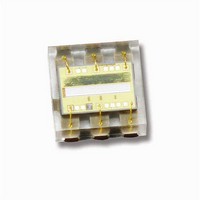TSL2561CL TAOS, TSL2561CL Datasheet - Page 23

TSL2561CL
Manufacturer Part Number
TSL2561CL
Description
Light to Digital Converters Ambient Light Sensor Light to Digital
Manufacturer
TAOS
Datasheet
1.TSL2561T.pdf
(42 pages)
Specifications of TSL2561CL
Data Bus Width
20 bit
Peak Wavelength
640 nm, 940 nm
Maximum Operating Frequency
780 KHz
Operating Supply Voltage
2.7 V to 3.6 V
Operating Current
0.6 mA to 15 uA
Maximum Operating Temperature
+ 70 C
Minimum Operating Temperature
- 30 C
Interface Type
I2C
Maximum Fall Time
300 ns
Maximum Rise Time
300 ns
Mounting Style
SMD/SMT
Resolution
16 bit
Package / Case
Chip LED
Lead Free Status / RoHS Status
Lead free / RoHS Compliant
Calculating Lux
Simplified Lux Calculation
The LUMENOLOGY r Company
The TSL256x is intended for use in ambient light detection applications such as display backlight control, where
adjustments are made to display brightness or contrast based on the brightness of the ambient light, as
perceived by the human eye. Conventional silicon detectors respond strongly to infrared light, which the human
eye does not see. This can lead to significant error when the infrared content of the ambient light is high, such
as with incandescent lighting, due to the difference between the silicon detector response and the brightness
perceived by the human eye.
This problem is overcome in the TSL256x through the use of two photodiodes. One of the photodiodes
(channel 0) is sensitive to both visible and infrared light, while the second photodiode (channel 1) is sensitive
primarily to infrared light. An integrating ADC converts the photodiode currents to digital outputs. Channel 1
digital output is used to compensate for the effect of the infrared component of light on the channel 0 digital
output. The ADC digital outputs from the two channels are used in a formula to obtain a value that approximates
the human eye response in the commonly used Illuminance unit of Lux:
CS Package
For 0 < CH1/CH0 0.52
For 0.52 < CH1/CH0 0.65
For 0.65 < CH1/CH0 0.80
For 0.80 < CH1/CH0 1.30
For CH1/CH0 > 1.30
T, FN, and CL Package
For 0 < CH1/CH0 0.50
For 0.50 < CH1/CH0 0.61
For 0.61 < CH1/CH0 0.80
For 0.80 < CH1/CH0 1.30
For CH1/CH0 > 1.30
The formulas shown above were obtained by optical testing with fluorescent and incandescent light sources,
and apply only to open-air applications. Optical apertures (e.g. light pipes) will affect the incident light on the
device.
Below is the argument and return value including source code (shown on following page) for calculating lux.
The source code is intended for embedded and/or microcontroller applications. Two individual code sets are
provided, one for the T, FN, and CL packages, and one for the CS package. All floating point arithmetic
operations have been eliminated since embedded controllers and microcontrollers generally do not support
these types of operations. Since floating point has been removed, scaling must be performed prior to calculating
illuminance if the integration time is not 402 ms and/or if the gain is not 16 as denoted in the source code on
the following pages. This sequence scales first to mitigate rounding errors induced by decimal math.
extern unsigned int CalculateLux(unsigned int iGain, unsigned int tInt, unsigned int
ch0, unsigned int ch1, int iType)
APPLICATION INFORMATION: SOFTWARE
Lux = 0.0315 CH0 − 0.0593 CH0 ((CH1/CH0)
Lux = 0.0229 CH0 − 0.0291 CH1
Lux = 0.0157 CH0 − 0.0180 CH1
Lux = 0.00338 CH0 − 0.00260 CH1
Lux = 0
Lux = 0.0304 CH0 − 0.062 CH0 ((CH1/CH0)
Lux = 0.0224 CH0 − 0.031 CH1
Lux = 0.0128 CH0 − 0.0153 CH1
Lux = 0.00146 CH0 − 0.00112 CH1
Lux = 0
r
www.taosinc.com
LIGHT-TO-DIGITAL CONVERTER
r
TSL2560, TSL2561
Copyright E 2009, TAOS Inc.
1.4
TAOS059N − MARCH 2009
1.4
)
)
23




















